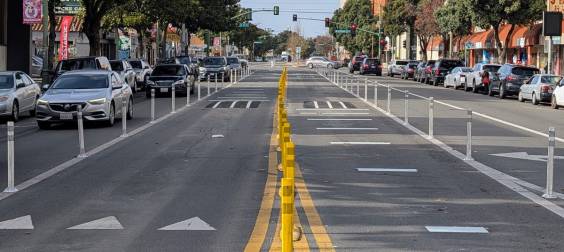
San Mateo County's City/County Association of Governments (C/CAG) is leaving an expansion of Highway 101 with new carpool lanes on the table, even after the Metropolitan Transportation Commission (MTC) concluded they will jam up with traffic the day they open. If constructed--by 2024 at the earliest--a 14-mile section of the highway from San Bruno to Redwood City would be widened from eight to ten lanes at a cost of up to $250 million.
MTC says traffic will move faster in all lanes, and carry more people in fewer vehicles, if the existing left-most lanes are converted to Express Lanes instead. Free for buses and carpools, and available to solo drivers for a toll, express lanes have cut traffic on Highways 680, 880, 580, and 237 by maintaining a congestion-free lane even during rush hours. On Highway 101 such lanes could help pay for express bus and van services. The express lane conversion could be completed in three years and cost $110 million less than the carpool lane expansion favored by C/CAG.
"It would be a huge missed opportunity if we can't use innovative strategies to cut traffic by moving more people in fewer vehicles along the Bay Area's most critical transportation corridor," said TransForm Community Planner Clarrissa Cabansagan. TransForm published a study in 2013 [PDF] making the case for converting existing lanes to express lanes on Highway 101 rather than widening it.
Express lane revenues could fund transit improvements, including Caltrain capacity upgrades and express SamTrans bus services that have been cut in recent years. Revenues could also subsidize other vehicle trip reduction programs including discounted or free transit passes or credits to use car-sharing and bike-sharing services.

But the county's transportation agencies are still trying to build their way out of congestion by funding highway expansions rather than alternatives to driving. C/CAG has been planning the Highway 101 carpool lane expansion since 2009 and reported to its Board of Directors in March 2015 [PDF] that "additional efforts spent on further analyzing [the conversion of an existing lane into an express lane] should be minimized due to potential additional travel time delay and potential impact on local streets."
That conclusion ignores the effects of induced demand and potential transit improvements. C/CAG's forecasts exclude many potential transit upgrades and Transportation Demand Management (TDM) programs that could be funded by the $110 million in construction cost savings and express lane toll revenues.
"An integrated multi-modal approach is sadly lacking in the conventional transportation planning approach and the forecasts associated with that," said former C/CAG Transportation Programs and Planning Manager Joseph Kott. "There was no accounting for the emergence of Transportation Management Associations all along the Peninsula, nor the potential for Bus Rapid Transit on El Camino Real, nor for operating more public and private buses including subsidized vanpools on Highway 101."
C/CAG plans to begin the environmental review of various options for dealing with the highway's chronic traffic jams within the next few months. The agency hasn't yet announced whether express lanes will be considered nor which transit improvements the toll revenues would fund if built.





